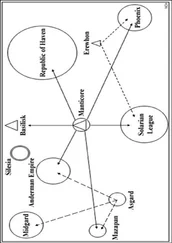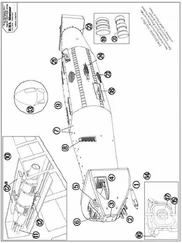David Weber - In Enemy Hands
Здесь есть возможность читать онлайн «David Weber - In Enemy Hands» весь текст электронной книги совершенно бесплатно (целиком полную версию без сокращений). В некоторых случаях можно слушать аудио, скачать через торрент в формате fb2 и присутствует краткое содержание. ISBN: , Издательство: Baen Publishing Enterprises, Жанр: Фантастика и фэнтези, на английском языке. Описание произведения, (предисловие) а так же отзывы посетителей доступны на портале библиотеки ЛибКат.
- Название:In Enemy Hands
- Автор:
- Издательство:Baen Publishing Enterprises
- Жанр:
- Год:неизвестен
- ISBN:0-671-57770-0
- Рейтинг книги:3 / 5. Голосов: 1
-
Избранное:Добавить в избранное
- Отзывы:
-
Ваша оценка:
- 60
- 1
- 2
- 3
- 4
- 5
In Enemy Hands: краткое содержание, описание и аннотация
Предлагаем к чтению аннотацию, описание, краткое содержание или предисловие (зависит от того, что написал сам автор книги «In Enemy Hands»). Если вы не нашли необходимую информацию о книге — напишите в комментариях, мы постараемся отыскать её.
In Enemy Hands — читать онлайн бесплатно полную книгу (весь текст) целиком
Ниже представлен текст книги, разбитый по страницам. Система сохранения места последней прочитанной страницы, позволяет с удобством читать онлайн бесплатно книгу «In Enemy Hands», без необходимости каждый раз заново искать на чём Вы остановились. Поставьте закладку, и сможете в любой момент перейти на страницу, на которой закончили чтение.
Интервал:
Закладка:
The Prince Consort -class ships like Prince Adrian were the product of a design philosophy which had been abandoned with the emergence of the later Star Knights . The Prince Consorts ' original design was over sixty T-years old, dating back to the very first installment of the naval build-up Roger III had begun to counter the PRH's expansionism, and they hadn't been intended to function as flagships. Instead, in an effort to get as much firepower into space as quickly—and for as low a cost—as possible, BuShips' architects had chosen to omit a proper flag deck and all its support systems and used the freed mass to tuck an extra graser and an extra pair of missile launchers into each broadside. In fact, even their regular command decks had been built to unusually austere standards to help compensate for the increased armament and more magazine space. Instead of the extra, unused bridge volume BuShips normally allocated to new designs to provide room for the proliferation of control systems which always occurred, the Prince Consorts had been given just enough room for their original requirements. Which meant their bridges had become increasingly cramped as inevitable refits jammed in supplementary consoles and displays and panels anywhere a few cubic centimeters could be found for them.
The problem had been recognized at the time, but accepted as an unavoidable consequence of producing ships with maximum firepower for their cost and tonnage, and BuShips had projected a program which would have built the Prince Consorts in groups of seven and paired each group with a Crusader -class ship which did have a flag deck to make a full eight-ship squadron. Unfortunately, what had seemed like a good idea at the time had begun to look very different since the outbreak of the Navy's first serious shooting war in a hundred and twenty T-years.
The original Crusader building program had failed to allow for the unavoidable cycle of overhauls any warship required, with the result that at least twenty-five percent too few flagships had been allowed from the beginning, and Sir Edward Janacek's decision to cut funding for the Crusaders by over seventy percent during his first tenure as First Lord of the Admiralty had only made bad worse. But Janacek had viewed the Navy's proper role as anti-piracy patrols and defense of the Manticore Binary System itself. Anything more "aggressive" than that had clashed with his Conservative Party prejudice against "imperialist adventures" which were likely to "provoke" the People's Republic, and he'd regarded the deployment of cruiser squadrons to distant stations as the precursor to the gunboat diplomacy he rejected.
One way to hamstring such deployments was to cut down on the number of available flagships, which was precisely what he'd done, although he'd been careful to make the Crusaders' higher cost per unit his official reason. During his tenure, more than half the Navy's total cruisers had been tasked for solo operations chasing pirates on distant stations (for which no command ships were required), and most of the remainder had been concentrated in one spot and attached to Home Fleet, where only a limited number of flagships were needed. As a result, the implications of the shortage of Crusaders had gone largely unobserved at the time.
That, unfortunately, was no longer true. Janacek had been out of office for eleven T-years now, but the pernicious effects of his funding decisions lingered on. Numerically, the Crown Princes were the largest single class of heavy cruisers in the RMN's inventory, yet their lack of squadron command facilities severely limited their utility. The fact that the bigger, less numerous Star Knights ' flag accommodations forced the Admiralty to keep tapping them for the detached command roles the Crown Princes couldn't fulfill properly also meant that the newer ships had suffered higher proportional losses. Prince Adrian and her sisters tended to stay tethered to task force and fleet formations, where someone else could provide the space for a commodore or admiral and her staff. That meant they were normally found in company with ships of the wall, whereas the Star Knights , exposed on frontier and convoy deployments without capital ship support, were much more likely to find themselves engaged with fast battlecruiser/cruiser-level raiding forces. And, of course, every Star Knight lost to enemy action or sent to the yard by battle damage reduced the supply of command ships by yet another unit.
There wasn't actually all that much to choose between the individual offensive power of the two classes, which—given the difference in their tonnages—only went to prove that even the Star Knights' design was less than perfect. Powerful as the Star Knights were, too little of their volume was allocated to offensive systems, in Honor's opinion, and too much was used on defense, probably as a reaction against the perceived shortcomings of their predecessors.
The newer class's more powerful sidewall generators, heavier armor, better electronic warfare capabilities, and more numerous point defense systems made them at least thirty percent tougher than the older Prince Consorts , and BuShips fully recognized the need for a better balance between offense and defense. Unfortunately, the need for cruiser flagships meant the yards were churning out Star Knights as quickly as they could—given the limited amounts of space which could be diverted from capital ship construction for any sort of cruiser—and that had significantly delayed introduction of the new Edward Saganami -class ships. The Saganamis , ten percent larger than the Star Knights and designed to take full advantage of the Navy's current battle experience and to incorporate the best balance of Grayson and Manticoran concepts, should have entered the construction pipeline over three T-years ago, but BuShips had decided it couldn't afford to divert building capacity to a new class (which, undoubtedly, would have its own share of production-oriented bugs to overcome) when the need for volume production was so acute. And so the Star Knights continued to be built to a basic design which was now eighteen years old. To be sure, their design had been on the cutting edge when it was finalized, and—like the Prince Consorts —they had been materially upgraded since, but even with as heavy a refit schedule as deployment pressures would permit, the class was losing its superiority over the Peeps.
In a way , Honor thought, standing to one side while she watched McKeon's bridge crew, that illustrates the entire problem Earl White Haven and I... disagreed over. (She was slightly—and pleasantly—surprised to feel only the smallest twinge as she thought about the earl.) We've still got the tech edge on a ship-for-ship, ton-for-ton basis, but it's shrinking. We can't afford that, but unless we can somehow find a way to break the traditional building patterns, our advantage is going to continue to erode. It won't be anything dramatic or obvious in the short term, but in the long term ...
She gave herself a mental shake and commanded herself to stop woolgathering and pay attention as Lieutenant Commander Sarah DuChene, McKeon's astrogator, completed her final course adjustments and looked at her captain.
"Ready to translate in eight minutes, Sir."
"Very good. Communications, inform the flagship," McKeon said.
"Aye, aye, Sir. Transmitting now." Lieutenant Russell Sanko, Prince Adrian 's com officer, depressed a key to send the stored burst transmission. "Transmission complete, Sir."
"Thank you. Very well, Sarah. The con is yours."
Читать дальшеИнтервал:
Закладка:
Похожие книги на «In Enemy Hands»
Представляем Вашему вниманию похожие книги на «In Enemy Hands» списком для выбора. Мы отобрали схожую по названию и смыслу литературу в надежде предоставить читателям больше вариантов отыскать новые, интересные, ещё непрочитанные произведения.
Обсуждение, отзывы о книге «In Enemy Hands» и просто собственные мнения читателей. Оставьте ваши комментарии, напишите, что Вы думаете о произведении, его смысле или главных героях. Укажите что конкретно понравилось, а что нет, и почему Вы так считаете.












